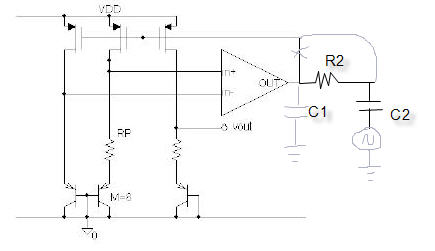stoned
Member level 3

1/f noise and bandgap
Hi all:
The PM of the whole loop should be considered carefully to avoid oscillations.
So I want to confirm it and get PM of the whole loop of my circuit by simulating. The figure as the following.
I break the loop at the Opamp output node, and add AC source series a capacitance at the gate of the top PMOS, and plot the Amp out node result. But the result is about -20dB of opamp output node. It’s right?
Can somebody give me the detail method of simulation to get PM?
Large signal stability:
I calculated the positive and negative feedback respectively, finding that positive is large than the negative, but the sum is small than unit.
When I ramp the Vdd from 0 to Vdd during 1ns, the BandGap will be stable after 3us, and with some ring during these time, so I think the phase margin is not enough, how to solve this problem? Add capacitance between out and ground?
Noise:
Does noise simulation required the noise model? When I use the following cmd to simulate.
vdd vdda 0 vol ac=1
.ac dec 10 .1 10
.noise v(vref) vdd
.print noise inoise
the result is
**** the results of the sqrt of integral (v**2 / freq)
**** total output noise voltage = 63.5984u volts
**** total equivalent input noise = 200.0866m volts
******
how to simulate the noise?
Thanks a lot!
stoned
Hi all:
The PM of the whole loop should be considered carefully to avoid oscillations.
So I want to confirm it and get PM of the whole loop of my circuit by simulating. The figure as the following.
I break the loop at the Opamp output node, and add AC source series a capacitance at the gate of the top PMOS, and plot the Amp out node result. But the result is about -20dB of opamp output node. It’s right?
Can somebody give me the detail method of simulation to get PM?
Large signal stability:
I calculated the positive and negative feedback respectively, finding that positive is large than the negative, but the sum is small than unit.
When I ramp the Vdd from 0 to Vdd during 1ns, the BandGap will be stable after 3us, and with some ring during these time, so I think the phase margin is not enough, how to solve this problem? Add capacitance between out and ground?
Noise:
Does noise simulation required the noise model? When I use the following cmd to simulate.
vdd vdda 0 vol ac=1
.ac dec 10 .1 10
.noise v(vref) vdd
.print noise inoise
the result is
**** the results of the sqrt of integral (v**2 / freq)
**** total output noise voltage = 63.5984u volts
**** total equivalent input noise = 200.0866m volts
******
how to simulate the noise?
Thanks a lot!
stoned




